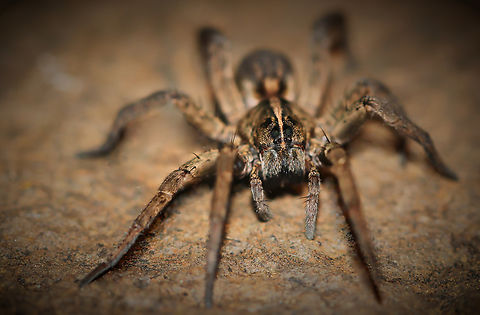Wetland Giant Wolf Spider
Tigrosa helluo
"Tigrosa helluo", commonly known as the Wetland Giant Wolf Spider, is a species of spider belonging to the family Lycosidae, also known as wolf spiders. "T. helluo" was formerly known as "Hogna helluo" before differences between dorsal color patterns, habitat preferences, body structures, etc. were discovered. The species is native to the United States, Canada, and Mexico. It can be found across the eastern half of the United States, primarily in the Northeast and New England, and as far west as Nebraska and Kansas. "T. helluo" can be found in diverse habitats including woods, marshes, fields, and riparian areas. Typically, members of this species prefer to live in wetter areas as opposed to dry environments. Males tend to live for around a year and females will live for close to two years.
The defining characteristic of "T. helluo" is its brown carapace and distinct yellow stripe starting from its anterior eyes extending down the cephalothorax. The underside of the abdomen has distinct black spots that distinguish "T. helluo" from other wolf spiders. At an average size of around 17 mm, "T. helluo" is one of the smaller wolf spiders. In addition, females tend to be larger than males in a display of sexual dimorphism.
Like other spiders of the family Lycosidae, wolf spiders are solitary and live and hunt alone. Unless in the process of mating, "T. helluo" will remain alone. It is usually active at night, during which it hunts for prey. In addition, "T. helluo" does not create webs, although females will make burrows under rocks or boards. Relying on their excellent eyesight and senses, "T. helluo" members are great hunters.
Members of "T. helluo" are not very aggressive and will not attack humans unless provoked. Their bites inject venom; however, it is not medically significant to humans, as only minor pain and swelling occur. Antivenom is rarely needed.
The defining characteristic of "T. helluo" is its brown carapace and distinct yellow stripe starting from its anterior eyes extending down the cephalothorax. The underside of the abdomen has distinct black spots that distinguish "T. helluo" from other wolf spiders. At an average size of around 17 mm, "T. helluo" is one of the smaller wolf spiders. In addition, females tend to be larger than males in a display of sexual dimorphism.
Like other spiders of the family Lycosidae, wolf spiders are solitary and live and hunt alone. Unless in the process of mating, "T. helluo" will remain alone. It is usually active at night, during which it hunts for prey. In addition, "T. helluo" does not create webs, although females will make burrows under rocks or boards. Relying on their excellent eyesight and senses, "T. helluo" members are great hunters.
Members of "T. helluo" are not very aggressive and will not attack humans unless provoked. Their bites inject venom; however, it is not medically significant to humans, as only minor pain and swelling occur. Antivenom is rarely needed.
